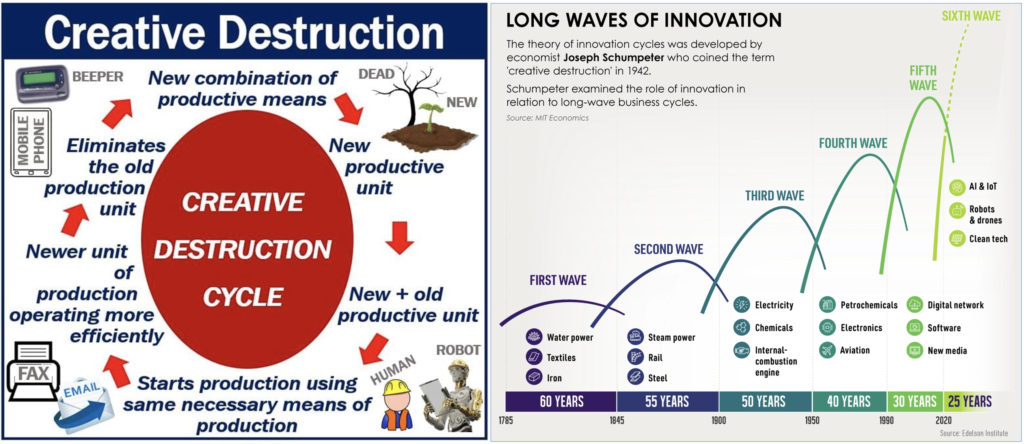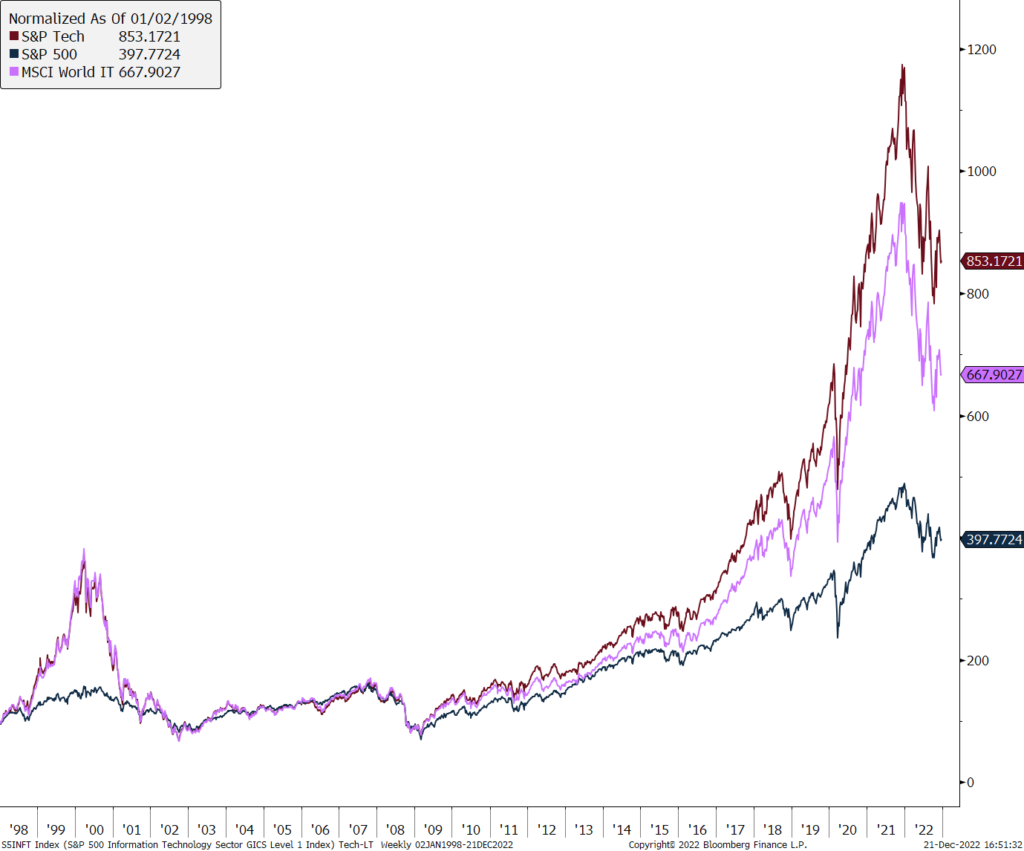Technological innovations have been the fundamental blocks of human development forever, but more so since the beginning of the 20th century. People used to do everything using their physical power. Now, a person with mechanical equipment, and sometimes an automated machine alone, can do what several people may not be able to accomplish just a few decades ago.
The pace of innovations and convergence of exponential technologies are gathering unprecedented momentum to solve global challenges, including climate change. Doing so will inevitably disrupt the old business models giving way to new ones—creative destruction in action! Joseph Schumpeter, in 1942 first characterized creative destruction as innovations in the manufacturing process that increase productivity, describing it as the “process of industrial mutation that incessantly revolutionizes the economic structure from within, incessantly destroying the old one, incessantly creating a new one.”

Technology investments have created immense wealth over the last few decades. However, the innate nature of technology is growth-oriented, which means a higher risk and higher return. Therefore, in risk-averse environments such as now, the markets may reduce investments, which leads to a correction in the sector. Here, I’m not primarily talking about the companies like Alphabet and Meta that generate revenues primarily by advertising, but the IT companies that sell technology-related hardware and software. The sector has witnessed steep stock price declines periodically, often more than broader markets leading many to believe that the industry could remain in a bear market for long periods.
This year is one of them, where many are referring to the “tech wreck of 2022” and assuming that the IT sectors’ best days may be over, at least for the foreseeable future. The rising interest rates, geopolitical fragility, and the fear of supply chain disruption have hit technology stocks and their IPO market. An analysis by Meritech suggests that the cumulative market capitalization of the fastest-growing software-as-a-service (SaaS) stocks had fallen almost 70%. The technology sector’s IPO volume has reduced by 80% y-o-y in the first half of 2022, while the number of late-stage financing rounds collapsed for emerging startup companies.
But, as the below chart (S&P Tech Index and MSCI World IT Index compared to S&P 500 Index) shows, over the last 25 years, the technology sector has fallen in a risk-off environment and has bounced back faster and stronger than the rest of the market after that. Although the index considered here has companies like Alphabet and Meta, the outperformance still holds without them.
In each global selloff in the last 25 years, including the great financial crisis in 2008 and COVID-19 in early 2020, the technology sector correction was deeper than S&P 500. Still, the returns in these events’ aftermath were massive almost every time.

Would you bet against the turnaround in the technology sector, especially now that innovations are accelerating, creating more value for each company and industry besides solving grand challenges? I will not!
See the picture below from a presentation by Tony Seba. Within just a few years, cars took over the horse buggies. That’s true creative destruction! We now see similar events around us, albeit happening at a much faster pace. Autonomous cars and flying taxis could become mainstream similarly in just a few decades.

The common understanding is that the country’s leadership and bureaucrats lead to economic and social progress. However, if you pay close attention, you will see that technological advancements lay the foundation of development.
Historically, governments worldwide have not been quick to accept, encourage, and adopt technological transformation. The vote bank is in danger most of the time, citing reasons such as the loss of jobs due to automation. Most often, the group of innovators and forward-thinking investors will keep pushing the idea into practice with little policy and funding support from the governments. The technological breakthroughs then one day become so essential and lucrative that turning them down start looking foolish. At that time, the government bowed down to make policies and provide funding for technological advancements, which led to socioeconomic progress.
Consider this; until a decade ago, every country seems to like solar as a solution to carbon emissions from power generation. Novel innovations in bringing down the cost of installing solar, becoming comparable to fossil fuel, pushed the governments in its favor. Now, every government around the world has ambitious solar deployment goals.
Massive socio-economic development is underway not only in technologically advanced countries, but innovations are enabling the global south to leapfrog the wealthy world at an unprecedented pace.
Picture this: While I was growing up in India at the turn of the century, business process outsourcing (BPO) was becoming a dream job of every person in India after software development. BPOs became a possibility because internet-based communication became cheap enough to make economic sense for someone from the U.S. to call customer care, talk to a specialist in India, and resolve the concern. The BPOs created jobs with good salaries. People in my social circle often asked me to get a job in BPOs while I was in college, saying that most start at a salary higher than their father’s wages at retirement.
But there is more to the story. They not only created quality jobs and bought much-needed international presence and, of course, $$ to the economy, but they also led to overall real estate development to accommodate fancy offices and provided business opportunities to food vendors, cab drivers, and all the maintenance staff. The socioeconomic development was unparalleled.
We all know the transformation bought by the advent of smartphones. Remember how quickly landlines gave way to mobile phones; now, smartphones are pervasive. It democratized and demonetized several services and products we used separately. I remember the first time I visited the United States in 2006. I used to buy a $5 calling card that would allow me to call my home in India once or twice a week for a couple of minutes. Now, I talk to my parents, friends, and relatives on FaceTime without worrying about the time and at a fraction of that cost. This is nothing short of magical progress.
We now even have wifi on a plane, 34,000 feet in the sky; it was unthinkable just a few years ago.Imagine how much business activity will increase, and social upliftment will happen when the rest of the unconnected world can access the internet through programs such as Elon Musk’s OneWeb program.
The disruption is not limited to a country or a particular economic sector. Technology is becoming the heart and soul of every company’s growth strategy. No industry is untouched by technology. Innovation is racing ahead to make everything bigger, better, faster, and cheaper.
Every company is integrating technology to connect closely with customers in every corner of the world, innovate rapidly, and gain efficiency in operations. Cloud computing helped us navigate the tough times during COVID-19, and businesses could still operate with remote work amid lockdowns. Industrial processes and the services sector are digitizing, and decisions are being made using data, where digital twins are helping virtually see possible outcomes of a specific solution and adjust accordingly to get desired results. AI/ML and the internet of things are becoming pervasive in decision-making. DNA sequencing and gene editing are promising to treat and even cure chronic conditions, expanding a healthy lifespan.
The human mind has the ability of limitless creative imagination. The technological advancements have reached a point where they themselves provide further resources for faster innovation. Ray Kurzweil describes this as the “Law of Accelerating Returns.”
Human evolution may have reached its pinnacle in physicality, but our mind is boundless and will keep evolving and innovating. In our lifetime, we will likely see paradigm shifts in how we live, interact, do commerce, and travel, along with solutions to leave the planet better than we inherited.
#neverarrive #limitlesspotential
I’m grateful for your time in reading this blog. In the comments section, let me know your experience and perspective on the subject. Please share the blog with your friends if you enjoyed reading it.
**Disclaimer: Views expressed here are personal and do not represent any institution or entity I’m associated with.
